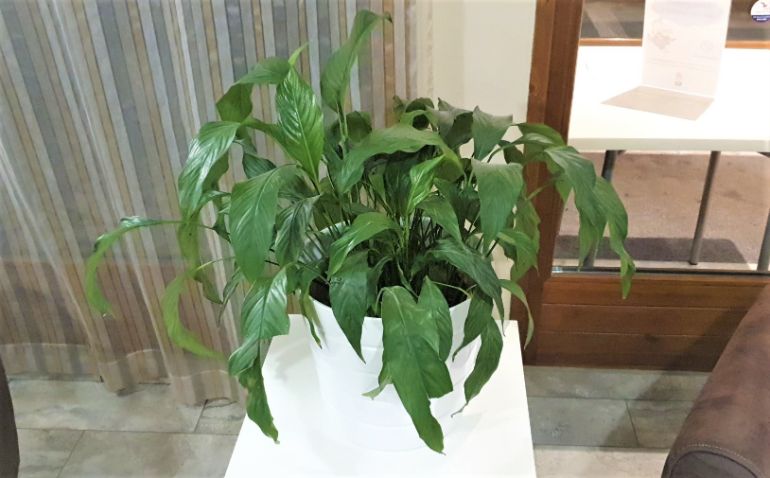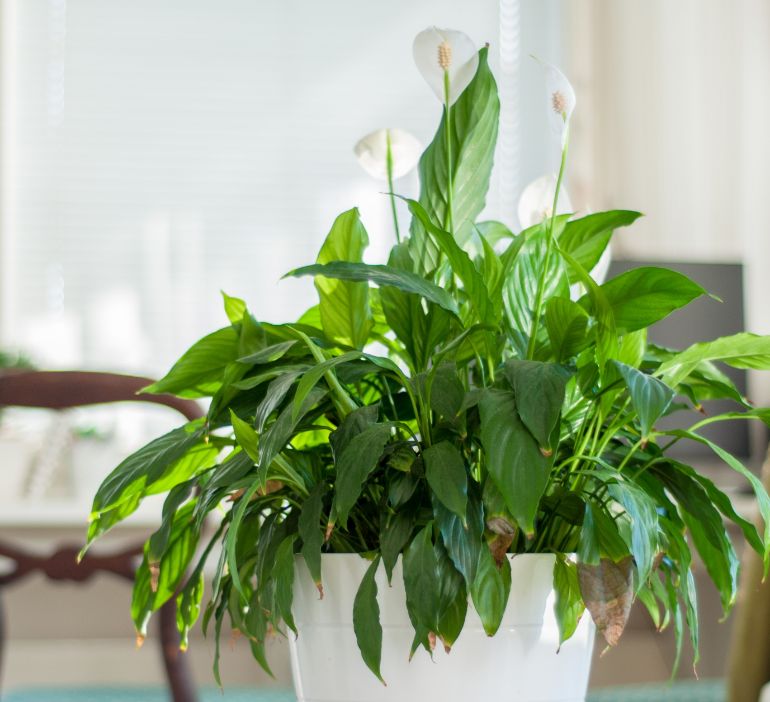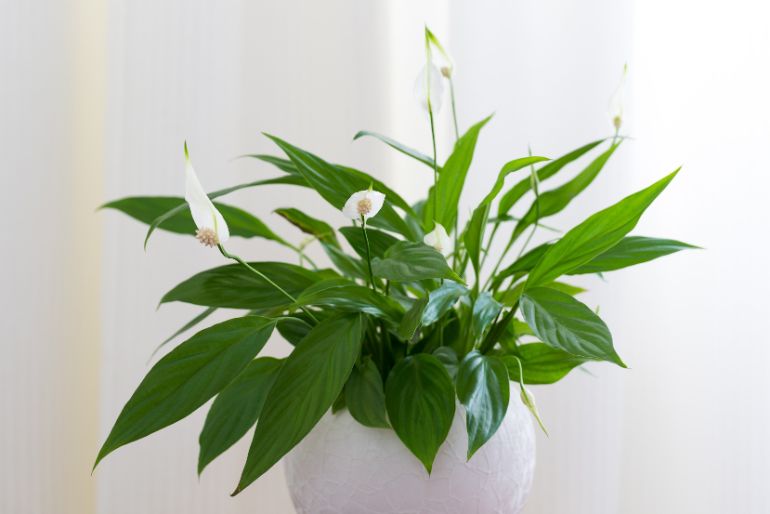Peace Lilies are the ultimate low-maintenance flowering houseplant, famed for their beautiful spathes and elegant, dark green leaves. Although normally pitched as an easy-care houseplant, there are many issues that can result in your Peace Lily not growing. This article is going to help you work out why your Peace Lily has stopped growing and show you how to get your plant back on track.
Insufficient light is the most common cause of a Peace Lily not growing. Peace Lilies need bright, indirect light so they have enough energy to grow. Peace Lilies also stop growing if they are stressed due to problems such as overwatering, overfertilizing, temperature extremes, or pests.
What To Do If Your Peace Lily Is Not Growing
If you notice that your Peace Lily isn’t growing, the first thing to do is check your plant carefully for any other signs that it isn’t happy. You should take time to look at the growing conditions, as well as examining the plant carefully for any problems.
Here is the process I use to work out what is causing the problem;
- Consider lighting first – Low light will prevent your Peace Lily from growing. Make sure you are providing bright light, but avoid excessive direct sunlight, as this can damage the foliage.
- Look for signs of overwatering – Soggy soil can cause root rot, which will prevent your plant from growing. Brown leaf tips, drooping despite wet soil, and a rotting smell coming from the soil are signs of severe overwatering and root rot. Make sure your plant is in well-draining soil and a pot with drainage holes.
- Fertilizer Problems – Applying fertilizer too often can damage the roots, preventing new growth. Look for white crusts on the soil surface or brown patches or tips on the leaves. Peace Lilies have low fertilizer requirements.
- Pests – Inspect your plant closely for signs of pests. Look for speckled yellow patches on the leaves or evidence of the pests themselves. A plant that is fighting a pest infestation will not usually produce new growth.
- Temperature – Temperature extremes or drafts can stress your plant a lot and prevent it from producing new flowers or leaves. Make sure to place your plant in a location away from drafts or temperature extremes.
It is possible there may be several small issues, which together result in your Peace Lily not growing. As you examine your plant and its growing conditions, make small adjustments as needed, as these will all likely help your plant resume its growth.
Let’s now look at a number of the more common issues in more detail to help get your Peace Lily back on track.
Light
Whilst Peace Lilies are often marketed as low-light plants, they won’t thrive in dull conditions. They can survive and look quite well in lower light conditions for longer than many other houseplants, but they won’t get enough energy from the sun to grow.
Peace Lilies do best in bright, indirect light. This means that the light should be as bright as possible, without exposing your plant to direct sunlight. Here is a quick way to check whether your plant is in bright, indirect light.
- Hold your hand up about 1 foot away from the floor or wall near your plant.
- Look at the shadow your hand casts.
- Bright indirect light will cast a shadow with a slightly hazy outline.
- Low light will produce a very faint shadow or none at all.
At the other end of the lighting spectrum, a little direct sunlight won’t kill your plant, but excessive direct sunlight can scorch the leaves and cause a lot of damage too.
Light changes depending on the time of day, season, weather, aspect of your room, and the distance your plant is from the window. You may need to monitor your plant over time to see whether the lighting is sufficient.
Light intensity drops massively as the distance from a window increases. Regardless of the aspect of your room, you can normally adjust lighting for Peace Lilies by adjusting the distance from the window.
I live in a fairly northern latitude, and my Peace Lilies spend much of the year in a northeast-facing room, sitting on the windowsill. I normally move them to a southwest-facing window in the winter, as the light intensity is really quite low for 3-4 months of the year.
If you’d like to learn more, I’ve written a separate article about light requirements for indoor plants, which covers any other info you need to know.

Water
Watering issues are the second most common cause of a Peace Lily not growing, but are the number one cause of a plant dying, so this is a really important aspect of care to get right.
Overwatering is a common problem with Peace Lilies and will result in your Peace Lily not growing, and may even kill it. It’s not so much watering too frequently, but letting your Peace Lily sit in soggy, poorly aerated soil conditions for a long time. This results in the roots struggling and dying due to root rot. Without healthy roots, the rest of the plant can’t grow, and if the problem is bad enough, the plant will be unable to survive.
Look for the following signs of overwatering to determine if this is the reason your Peace Lily is not growing;
- Water pools on the surface of the soil after watering and takes a long time to drain.
- Yellowing leaves, particularly older foliage.
- Brown tips on the leaves, often worst on new foliage.
- Your plant is wilting despite the soil being wet.
- There is an offensive rotting smell coming from the soil.
- Your Peace Lily is in a pot without drainage holes.
- You sometimes forget to empty the drip tray after watering.
If your Peace Lily has signs of overwatering, you will need to take action to fix the problem quickly. If the situation is quite mild, simply cutting back on watering, or repotting in better draining soil, or a pot with more drainage will be sufficient.
Moving to a brighter location will help the soil dry more quickly after watering, as the plant will use more water, and evaporation from the soil will be increased.
If the plant is really struggling, you should check for root rot. Slide the plant out of the pot and inspect the roots. If only a few roots are affected, you can prune the affected roots and repot in fresh soil. You can read more about the process in my article about identifying, treating, and preventing root rot.
If most of the roots are affected with root rot, you are better off disposing of the plant and chalking this one up to experience. I’ve yet to meet an indoor gardener who hasn’t lost at least one plant to root rot – it’s part of the learning process.
Whilst overwatering causes a lot of issues, underwatering can also result in your Peace Lily not growing. Peace Lilies are great at telling you when they need to be watered, as the plant will droop quite spectacularly once the soil dries out. The key is to water them just before they start to droop. However, if you consistently run late, and your Peace Lily wilts repeatedly through lack of water, this will cause your plant stress and prevent it from growing.
Fertilizer
Fertilizer problems can sometimes cause a Peace Lily to stop growing, but it is much more likely to be overfertilizing rather than underfertilizing. Most Peace Lilies can cope perfectly well with the nutrients already present in the soil, and unless it has been many, many years since it was repotted, or you are growing yours in a very nutrient deficient potting mix, then your plant likely won’t struggle too much.
Overfertilizing, on the other hand, particularly with synthetic fertilizer, can cause damage to the roots of the plant and result in your Peace Lily not growing. Although plants need nutrients for growth, they only need them in tiny quantities, as they make most of their own energy from sunlight. High concentrations of fertilizer are actually toxic and do more harm than good.
Adding a little compost to the potting mix when repotting can often mean no additional fertilizer is required for Peace Lilies. Alternatively, fertilizing no more than every 2-3 months during the growing season will make sure your Peace Lily has all the nutrients it needs to thrive.
I do actually use synthetic fertilizer, but I’m always careful to dilute it to half the recommended strength before applying. Alternatively, there are many good organic fertilizers that release their nutrients slowly and are less likely to cause issues. You can learn more about the options for fertilizing houseplants in this article.
If you think you may have overfertilized your Peace Lily, you should flush the soil with copious quantities of water to help wash excess fertilizer out of the soil. Alternatively, you could repot your plant in new soil, although repotting can also be stressful for a Peace Lily.
Acclimation
Bear in mind that your Peace Lily may experience a period of acclimation when you bring it home. It will have been grown in perfect conditions in the grower’s greenhouse but will then have endured the stress of being transported to the store, placed on display in suboptimal conditions, and then been transported to your home, where conditions will again be different.
If you notice your Peace Lily not growing for 1-2 months after bringing it home, you can consider this fairly normal. Try to provide conditions that keep your plant happy, and it will soon start producing new growth.
Transplant Shock
Repotting can be a stressful process for a plant, and it often takes a while for your Peace Lily to start growing again after the process. Even worse, sometimes a Peace Lily can wilt spectacularly as the roots temporarily shut down due to the stress of repotting.
It is generally best to repot in spring or summer, and try not to disrupt the roots unnecessarily. It is very tempting to loosen the roots of a rootbound plant prior to placing it in a new home, but this often does more harm than good.

How Do I Make My Peace Lily Grow Bigger?
To make your Peace Lily grow bigger, provide bright indirect light, monitor watering needs closely, and lightly fertilize your plant every 2-3 months. Address any issues promptly to prevent your plant from experiencing excess stress. Bear in mind that individual cultivars vary in size, with full-grown plants ranging from 1 to 4 feet tall.
Why Is My Peace Lily Not Growing Tall?
Peace Lilies typically grow towards the source of available light. As most people grow Peace Lilies where the primary source of light is a window, new growth tends to spread towards the light, rather than growing straight upwards.
When Peace Lilies are grown by the producer, they typically have overhead lighting and develop upright, compact growth. You may notice your Peace Lily becoming less upright over time due to the change in lighting in your home.
The New Leaves Of My Peace Lily Are Smaller Than Old Ones
If the new leaves of your Peace Lily are smaller than the old ones, it is likely that your plant does not have sufficient light. Chronic underwatering, or lack of nutrients in the soil can also result in the new foliage being smaller than existing foliage.
Why Is My Peace Lily Not Blooming?
The most common cause of a Peace Lily not blooming is insufficient light. Increasing light will normally encourage increased blooms. Bear in mind that Peace Lilies are normally treated with gibberellic acid to promote profuse blooming prior to sale. Whilst Peace Lilies can bloom for much of the year, it is unlikely to be as profuse as when you first purchased your plant. You can read about other reasons why Peace Lilies fail to bloom, and how to fix them, in this article.
Last Word
I’ve tried to cover most of the main causes of a Peace Lily not growing in this article, and hopefully, you’ve found it helpful. If you’re still struggling with your Peace Lily, I’ve written a number of other articles about common problems and general care that you will find below.
If you’d like to learn how to keep your houseplant thriving, and avoid many of the common problems, check out my book, “Houseplants Made Easy”. It contains everything you need to know to grow beautiful houseplants and keep them looking fantastic year after year.
- How To Care For Peace Lily Houseplants
- Why Does My Peace Lily Have Yellow Leaves? (And How To Fix It)
- Peace Lily Meaning And Symbolism
- 5 Peace Lily Problems (And Solutions)
- Why Do Peace Lilies Droop?
- Why Do Peace Lily Flowers Turn Green?
- 25 Hard To Kill Houseplants That Will Thrive In Your Home
- 19 Flowering Houseplants That Are Absolutely Stunning

